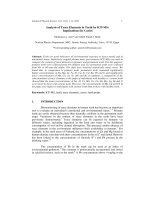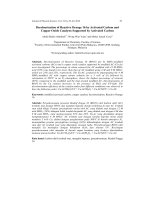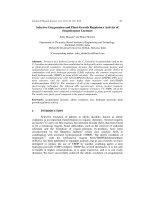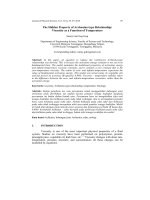Báo cáo vật lý: "Decolourisation of Reactive Orange 16 by Activated Carbon and Copper Oxide Catalysts Supported by Activated Carbon" ppsx
Bạn đang xem bản rút gọn của tài liệu. Xem và tải ngay bản đầy đủ của tài liệu tại đây (235.22 KB, 12 trang )
Journal of Physical Science, Vol. 21(2), 29–40, 2010 29
Decolourisation of Reactive Orange 16 by Activated Carbon and
Copper Oxide Catalysts Supported by Activated Carbon
Abdul Halim Abdullah
1*
, Wong Wan Yuan
1
and Mohd. Ismail Yaziz
2
1
Department of Chemistry, Faculty of Science,
2
Faculty of Environmental Studies, Universiti Putra Malaysia, 43400 UPM, Serdang,
Selangor, Malaysia
*Corresponding author:
Abstract: Decolourisation of Reactive Orange 16 (RO16) dye by HNO
3
-modified
activated carbons (ACs) and a copper oxide catalyst supported by modified AC (Cu-Ac)
were investigated. The percentage of colour removal for AC modified with 12 M HNO
3
acid (19%) was found to be lower than that of AC modified using 4 M and 8 M HNO
3
,
which are 23% and 22%, respectively. The Cu-AC, prepared by impregnating the 4 M
HNO
3
-modified AC with copper nitrate solution for a 5 wt% of Cu followed by
calcination at 500°C in an N
2
atmosphere, shows the highest percentage of removal
(63%) compared to the modified and the heat-treated modified AC. Decolourisation of
RO16 by the Cu catalyst increases in the presence of H
2
O
2
and UV-light. The
decolourisation efficiency of the catalyst under four different conditions was observed to
have the following order: Cu-AC/H
2
O
2
/UV > Cu-AC/H
2
O
2
> Cu-ACN/UV ≈ Cu-AC.
Keywords: modified activated carbon, copper catalyst, decolourisation, Reactive Orange
16
Abstrak: Penyahwarnaan pewarna Reaktif Jingga 16 (RO16) oleh karbon aktif (AC)
terubah suai dengan HNO
3
dan mangkin kuprum oksida terdokong di atas AC terubah
suai telah dikaji. Peratus penyingkiran warna oleh AC yang diubah suai dengan 12 M
asid HNO
3
(19%) didapati lebih rendah daripada AC yang diubah suai dengan 4 M dan
8 M asid HNO
3
, iaitu masing-masing 23% dan 22%. Cu-Ac yang disediakan dengan
mengimpregnasi 4 M HNO
3
- AC terubah suai dengan larutan kuprum nitrat untuk
memberi 5 wt% Cu, diikuti dengan pengkalsinan pada 500°C di bawah atmosfera N
2
,
menunjukkan peratus penyingkiran tertinggi (63%) dibandingkan dengan AC terubah
suai dan AC terubah suai yang dikenakan rawatan haba. Penyahwarnaan RO16 oleh
mangkin Cu meningkat dengan kehadiran H
2
O
2
dan sinaran UV. Kecekapan
penyahwarnaan oleh mangkin di bawah empat keadaan yang berbeza diperhatikan
menurut aturan berikut: Cu-AC/ H
2
O
2
/UV > Cu-AC/H
2
O
2
> Cu-ACN/UV ≈ Cu-AC.
Kata kunci: karbon aktif terubah suai, mangkin kuprum, penyahwarnaan, Reaktif Jingga
16
Decolourisation of Reactive Orange 16 Dye 30
1. INTRODUCTION
It is well known that catalysts of metal ions in solution or powder metal
oxides create an unstable state because the surface tension favours a smaller
interfacial area for a given mass. Catalysts also cause a secondary pollutant
problem that requires further treatment to remove the metal ion from water.
1
Therefore, attempts have been made to improve the catalysis process by replacing
the homogeneous catalysts with a heterogeneous catalyst. For this purpose,
supported metal catalysts can be prepared.
2
Activated carbon (AC) is one of the
most widely used catalyst supports in recent years
3–12
because of its high surface
area, well-defined porous structure, the presence of various surface functional
groups and its inertness in many catalytic processes.
8
Advanced oxidation processes (AOPs) are attractive alternatives to
conventional treatment methods. They have been used more frequently recently
due to the high oxidising power of free radicals. Production of these radicals is
achieved using either single oxidants or combinations of ozone, H
2
O
2
and UV
radiation
13
and a combination of H
2
O
2
with ferrous ions in Fenton’s reagent.
14
Because copper nitrate is one of the best catalysts in catalytic oxidation
of dyeing and printing wastewater, Cu is chosen to be loaded onto the porous
support. This study investigates the effect of HNO
3
-modified AC and its
corresponding Cu-supported catalyst on the decolourisation of Reactive Orange
16 (RO16) dye. The chemical structure of RO16 dye is shown in Figure 1.
Figure 1: The chemical structure of RO16 dye.
Journal of Physical Science, Vol. 21(2), 29–40, 2010 31
2. EXPERIMENTAL
2.1 Activated Carbon Modification
Commercial AC (KI7060, Kekwa Indah Sdn. Bhd., Malaysia) was
crushed and sieved. The carbon with a diameter between 300 and 500 μm was
collected and soaked in HCl (1 M) solution for 24 h. After treatment, the samples
were washed several times with hot distilled water and dried in oven at 100
o
C.
The samples were further treated by refluxing in different concentrations of
HNO
3
(1 g of AC per 10 ml of HNO
3
solution) for 4 h at 65
o
C. These samples
were later washed thoroughly with distilled water and dried in an oven overnight
at 110
o
C. A portion of the modified AC was calcined in an N
2
flow for 4 h at
500
o
C.
2.2 Catalyst Preparation
Copper oxide catalyst supported by modified AC (Cu-AC) was prepared
by the impregnation method that follows: the amount of copper (II) nitrate
trihydrate that will give 5 wt % of Cu was dissolved in approximately 100 ml of
deionised water and later introduced into a beaker containing the modified AC.
The mixture was gently heated (≈ 60
o
C) with constant stirring until a thick paste
was obtained. The paste was dried at 110
o
C for 2 h to remove the remaining
water, followed by calcination in an N
2
stream for 4 h at 500
o
C. The preparation
conditions and the modified AC and Cu catalysts are tabulated in Table 1.
Table 1: Experimental conditions for the preparation of modified AC and the corresponding Cu
catalysts.
Sample
Starting material
Treatment
AC
Commercial AC
Immersed in 1M HCl, 24 h, room
temperature
AC4
AC
Refluxed with 4 M HNO
3
, 4 h, ~65
o
C
AC8
AC
Refluxed with 8 M HNO
3
, 4 h, ~65
o
C
AC12
AC
Refluxed with 12 M HNO
3
, 4 h, ~65
o
C
AC4/500
AC4
Calcined in N
2
flow at 500
o
C, 4 h
AC8/500
AC8
Calcined in N
2
flow at 500
o
C, 4 h
AC12/500
AC12
Calcined in N
2
flow at 500
o
C, 4 h
Cu-AC4
AC4
Impregnated with 5% Cu, calcined in
N
2
flow at 500
o
C, 4 h
Cu-AC8
AC8
Impregnated with 5% Cu, calcined in
N
2
flow at 500
o
C, 4 h
Cu-AC12
AC12
Impregnated with 5% Cu, calcined in
N
2
flow at 500
o
C, 4 h
Decolourisation of Reactive Orange 16 Dye 32
2.3 Characterisation
The surface area and pore volume of the samples were analysed by N
2
adsorption at –196°C using the dynamic Brunauer-Emmett-Teller (BET) method
in a Micromeritic ASAP 2000 (USA) surface area analyser. The sample was
degassed at 250
o
C until a constant pressure at about 6 x 10
–6
torr was attained.
The X-ray diffraction (XRD) pattern was obtained using a Shimadzu XRD6000
(Japan) diffractometer with Ni-filtered Cu Kα radiation at a scanning rate of
2
o
min
–1
.
2.4 Removal of RO16 Dye
The decolourisation of RO16 (Aldrich, Singapore) was performed in a
batch experiment at room temperature. 1 g of modified AC or catalysts was
added to a beaker containing 1.0l of 25 mg l
–1
RO16 dye solution. Continuous
mixing at a constant rate was provided by a magnetic stirrer for 6 h. 5 ml of
aliquot was withdrawn at predetermined time intervals and filtered with a
Millipore membrane (0.45 μm) before analysis. The effect of H
2
O
2
and UV light
on the decolourisation of RO16 was carried out by adding a fixed amount of 1 M
H
2
O
2
solution and irradiating the dye solution with Blak-Ray B100 AP (Ultra-
Violet Product Ltd., UK) long wave (365 nm) UV lamp. The decolourisation of
RO16 was measured by a UV-Vis spectrophotometer (Lambda 20, Perkin Elmer,
USA) with a λ
max
of 492 nm.
3. RESULTS AND DISCUSSION
3.1 XRD and Surface Area and Porosity Analyses
The XRD pattern (Fig. 2) for the modified AC has a broad diffraction
peak at 2θ ≈ 22
o
and a sharp peak at 2θ ≈ 44
o
, which are assigned to the
disordered graphitic 002 plane and 10 plane, respectively.
15
The broad peak
indicates the amorphous nature of the AC. For the Cu-AC catalyst, peaks
characteristic of copper (I) oxide (Cu
2
O) at 2θ = 36.5° and 42.4°, and copper (II)
oxide (CuO) at 2θ = 35.5
o
and 38.7
o
were observed. The assignment of the peaks
was cross-referenced with the Joint Committee on Powder Diffraction Standards
(JCPDS) file for CuO (48–1548) and Cu
2
O (74–1230).
Journal of Physical Science, Vol. 21(2), 29–40, 2010 33
Figure 2: XRD pattern of modified ACs and Cu-AC.
Table 2 shows the surface area and porosity analysis of the modified AC
and the Cu catalysts. Even though the surface area decreased as the concentration
of HNO
3
increased, the difference was not significant. This indicates that HNO
3
treatment does not affect the textural properties of the AC. Instead, several
researchers
16–18
have reported that the HNO
3
treatment produced surface oxygen
groups that are acidic, such as carboxyl and anhydrides, at the entrance of the
micropores. Such fixation explains the observed reduction in surface area.
Temperature Programmed Desorption (TPD) results
17,18
showed that these surface
oxygen groups are removed upon heat treatment. Therefore the increase in
surface area that is observed for all heat-treated modified AC can be attributed to
the removal of some or all of the surface oxygen groups formed during HNO
3
treatment. The reduction in surface area for Cu-AC can be explained by Cu
2
O
and CuO deposition onto the external surface and inner porous surface of the AC.
The presence of these oxides increases the particle density, which causes the
specific surface area of the catalyst to decrease.
7
0 20 40 60
2 (degree)
Decolourisation of Reactive Orange 16 Dye 34
Table 2: The textural properties of modified AC and their corresponding Cu catalysts.
Sample
BET surface area
(m
2
/g)
Micropore area
(m
2
/g)
Micropore
volume (cc/g)
Average pore
diameter (nm)
AC
1046
850
0.40
2.8
AC4
1026
829
0.39
2.8
AC8
1023
799
0.37
2.7
AC12
1028
796
0.37
2.8
AC4/500
1108
873
0.40
2.7
AC8/500
1134
867
0.40
2.7
AC12/500
1113
825
0.39
2.8
Cu-AC4
1002
765
0.36
2.8
Cu-AC8
1015
781
0.36
2.8
Cu-AC12
1039
769
0.36
2.8
The N
2
adsorption isotherms obtained for different ACs and Cu-ACs are
shown in Figure 3. All the isotherms belong to type I in the Brunauer-Deming-
Deming-Teller (BDDT) classification, which is indicative of the presence of
micropores of different sizes. Similar isotherms have been observed by previous
studies for different activated charcoal cloth and AC samples.
17
The appearance
of hysteresis loops in the N
2
isotherms of samples are categorised as type H
4
. The
adsorption and desorption branches remain parallel over a wide range of relative
pressure, which indicates the highly microporous nature of the samples.
Figure 3: Adsorption-desorption isotherms of N
2
for AC, modified AC and Cu-AC.
Relative pressure (P/Po)
Volume adsorbed (cc/g)
Journal of Physical Science, Vol. 21(2), 29–40, 2010 35
3.2 Removal of RO16 Dye
The removal of colour by AC is influenced by the surface area and
surface chemistry of the AC. The results of the colour removal by the AC are
depicted in Figure 4. The colour removal is significantly reduced when HNO
3
-
treated ACs are used [Fig. 4(a)]. Because the textural property of these modified
ACs remains unchanged, the reduction in colour removal is attributed to the
formation of surface oxygen groups during HNO
3
treatment, which increases as
the concentration of HNO
3
increases. However, the colour removal was improved
when heat-treated AC were employed [Fig. 4(b)] because of the removal of
surface oxygen groups, especially carboxyl and anhydrides, and the increase in
surface area of the ACs upon heat treatment at 500°C.
Figure 4: The percentage of colour removal of RO16 dye by (a) AC and HNO
3
-modified
AC and by (b) heat-treated HNO
3
-modified AC.
Figure 5 shows that the colour removal percentage for the Cu-AC4
catalyst was the highest, even though it had the lowest surface area. The removal
is attributed to adsorption of the dye onto the copper oxides and AC. Therefore,
Cu-AC4 was chosen as the catalyst for removal of RO16 in further experiments.
Time (min)
(a)
Time (min)
(b)
Colour removal (%)
Colour removal (%)
Decolourisation of Reactive Orange 16 Dye 36
Figure 5: The colour removal of RO16 dye with Cu-AC catalysts.
3.3 Effect of H
2
O
2
and UV Irradiation
Preliminary work showed that RO16 is resistant towards direct UV-
photolysis and is difficult to oxidise with H
2
O
2
. The combination of UV and
H
2
O
2
only gives 16% colour removal. The colour removal percentage by the
Cu-AC4 catalyst in the presence of UV, H
2
O
2
and H
2
O
2
/UV are illustrated in
Figure 6.
Figure 6: The colour removal of RO16 dye by Cu-AC4 catalyst in the presence of UV,
H
2
O
2
and H
2
O
2
/UV.
Colour removal (%)
Colour removal (%)
Time (min)
Cu-AC4 Cu-AC8 Cu-AC12
100
80
60
40
20
0
0 50 100 150 200 250 300 350 400
Journal of Physical Science, Vol. 21(2), 29–40, 2010 37
The presence of H
2
O
2
and H
2
O
2
/UV enhanced the colour removal by
Cu-AC4. The improvement is attributed to the formation of hydroxyl radicals,
which are responsible for oxidising the dye, via copper oxide-catalysed and UV-
catalysed decomposition of H
2
O
2
. It should also be noted that H
2
O
2
has also been
used as an oxidising agent to modify the surface of AC.
19
Therefore, two
plausible reasons can be offered to explain the slight improvement in colour
removal observed when changing from Cu-AC4 to Cu-AC4/H
2
O
2
to
Cu-AC4/H
2
O
2
/UV. First, because a portion of the H
2
O
2
is used to oxidise the AC,
there are fewer hydroxyl radicals available to oxidise the dye. Second, the
formation of a surface oxygen group because of the reaction between the AC and
H
2
O
2
reduces the adsorption of dye on the AC.
It should be noted that the colour removal process occurred rapidly
within the first 60 min for Cu-AC, Cu-AC/H
2
O
2
and Cu-AC/H
2
O
2
/UV system.
However, as the contact time increases, the colour removal increases gradually.
Unlike Cu-AC, the colour removal for the other systems almost reached
equilibrium after 4 h. It is postulated that, during the oxidation of the dye, an
intermediate that is resistant to oxidation is formed that is removed through
adsorption on the AC. Because the processes of oxidation and adsorption
occurred simultaneously, the AC was quickly saturated with the adsorbate, and
thus, it reached its equilibrium state.
3.4 UV Spectra
The UV spectra were recorded during the colour removal process using
Cu-AC, Cu-AC/UV, Cu-AC/H
2
O
2
and Cu-AC/H
2
O
2
/UV. Similar trends were
observed for Cu-AC and Cu-AC/UV and for Cu-AC/H
2
O
2
and Cu-AC/H
2
O
2
/UV,
as depicted in Figure 7. A steady decline in the intensity of the 387 nm and 492
nm peaks observed in Figure 7(a) signifies the removal of the dye through the
adsorption process. The removal process is slightly different for Cu-AC/
H
2
O
2
/UV [Fig. 7(b)]. The decline in intensity of the 387 nm peak is accompanied
by a steady shift of the 492 nm peak to 540 nm. The disappearance can be
attributed to oxidation of the functional group responsible for the 387 nm peak. It
is therefore postulated that an intermediate formed that is responsible for the 540
nm peak, is resistant to oxidation and is removed by the adsorption process.
Decolourisation of Reactive Orange 16 Dye 38
Figure 7: UV-Vis absorption spectral changes of RO16 recorded at different time
intervals during (a) Cu-AC/UV
and (b) Cu-AC/H
2
O
2
/UV
process.
4. CONCLUSION
Even though the textural properties of the AC were not significantly
affected by the HNO
3
modification process, the significant reduction in colour
removal observed using modified AC compared to unmodified AC clearly
indicates the influence of surface functional groups on the adsorption process.
The colour removal is also significantly higher for Cu-AC than that for AC4/500,
which is attributed to the adsorption of the dyes on the Cu oxides. The efficiency
of the Cu catalyst in removing the colour of RO16 dye under different conditions
is as follows: Cu-AC/H
2
O
2
/UV > Cu-AC/H
2
O
2
> Cu-AC/UV ≈ Cu-AC. This
result is due to the adsorption-oxidation process that occurs when H
2
O
2
/UV and
H
2
O
2
are used. The oxidation process is attributed to the presence of hydroxyl
radical formed through copper oxide-catalysed and UV-catalysed decomposition
of H
2
O
2
.
5. ACKNOWLEDGEMENT
The authors thank the Ministry of Science and Environmental, Malaysia
for their financial support through IRPA grant 09-02-04-0747-EA001.
Absorbance
Absorbance
Wavelength (nm)
(a)
Wavelength (nm)
(b)
Journal of Physical Science, Vol. 21(2), 29–40, 2010 39
6. REFERENCES
1. Hu, X., Lei, L., Chu, H. P. & Yue, P. L. (1999). Copper/activated carbon
as catalyst for organic wastewater treatment. Carbon, 37(7), 631–637.
2. Al-Hayek, N. & Dore, M. (1990). Oxidation of phenols in water by
hydrogen peroxide on alumina supported iron. Water. Res., 24, 973–982.
3. El-Shobaky, G. A., El-Nabarawy, T., Fagal, G. A. & Ahmad, A. S.
(1993). Surface and catalytic properties of copper oxide supported on
Al
2
O
3
and active carbon. Mater. Lett., 17(5), 297–302.
4. Wang, S. & Lu, M. G. Q. (1997). Effects of oxide promoters on metal
dispersion and metal-support interactions in Ni catalysts supported on
activated carbon. Ind. Eng. Chem. Res., 36(12), 5103–5109.
5. Zhu, Z. H., Radovic, L. R. & Lu, G. Q. (2000). Effects of acid treatments
of carbon on N
2
O reduction by carbon-supported copper catalysts.
Carbon, 38(3), 451–464.
6. Zhu, Z., Liu, Z., Liu, S., Niu, H., Hu, T., Liu, T. & Xie, Y. (2000). NO
reduction with NH
3
over an activated carbon-supported copper oxide
catalyst at low temperatures. Appl. Catal., B, 26(1), 25–35.
7. Frank, L. Y. L. & Hu, X. (2003). A new system design for the
preparation of copper/activated carbon catalyst by metal-organic
chemical vapor deposition method. Chem. Eng. Sci., 58(3–6), 687–695.
8. Tsoncheva, T., Vankova, S. & Mehandjiev, D. (2003). Effect of the
precursor and the preparation method on copper based activated carbon
catalysts for methanol decomposition to hydrogen and carbon monoxide.
Fuel, 82(7), 755–763.
9. Zhao, J., Liu, Z. & Sun, D. (2004). TPO-TPD study of an activated
carbon-supported copper catalyst-sorbent used for catalytic dry oxidation
of phenol. J. Catal., 227(2), 297–303.
10. Tseng, H. H. & Wey, M. Y. (2004). Study of SO
2
adsorption and thermal
regeneration over activated carbon-supported copper oxide catalysts.
Carbon, 42(11), 2269–2278.
11. Barrabs, N., Just, J., Dafinov, A., Medina, F., Fierro, J. L. G., Sueiras,
J. E., Salagre, P. & Cesteros, Y. (2006). Catalytic reduction of nitrate on
Pt-Cu and Pd-Cu on active carbon using continuous reactor. The effect of
copper nanoparticles. Appl. Catal., B, 62(1–2), 77–85.
12. Park, S. J. & Kim, B. J. (2005). Oxidation behaviors of metallic copper
particles in NO reduction mechanism of copper/activated carbons.
J. Colloid Interface. Sci., 292(2), 493–497.
13. Glaze, W. H. & Kang, J. W. (1989). Advanced oxidation processes.
Description of a kinetic the oxidation of hazardous materials in aqueous
media with ozone and hydrogen peroxide in a semibatch reactor. Ind.
Eng. Chem. Res., 28(11), 1573–1587.
Decolourisation of Reactive Orange 16 Dye 40
14. Walling, C. H. (1975). Fenton’s reagent revisited. Acc. Chem. Res., 8(4),
125–131.
15. Short, M. A. & Walker, P. L. Jr. (1963). Measurement of interlayer
spacing and crystal sizes in turbostatic carbons. Carbon, 1(1), 3–9.
16. Noh, J. S. & Schwarz, J. A. (1990). Effect of HNO
3
treatment on the
surface acidity of activated carbons. Carbon, 28(5), 675–682.
17. Pradhan, B. K. & Sandle, N. K. (1999). Effect of different oxidizing
agent treatments on the surface properties of activated carbons. Carbon,
37(8), 1323 –1332.
18. Moreno-Castilla, C., Lopez-Ramon, M. V. & Carrasco-Marin, F. (2000).
Changes in surface chemistry of activated carbons by wet oxidation.
Carbon, 38, 1995–2001.
19. Moreno-Castilla, C., Ferro-Garcia, M. A., Joly, J. P., Bautista-Toledo, I.,
Carrasco-Marin, F. & Rivera-Utrilla, J. (1995). Activated carbon surface
modification by nitric acid, hydrogen peroxide and ammonium
peroxydisulfate treatments. Langmuir, 11(11), 4386–4389.









